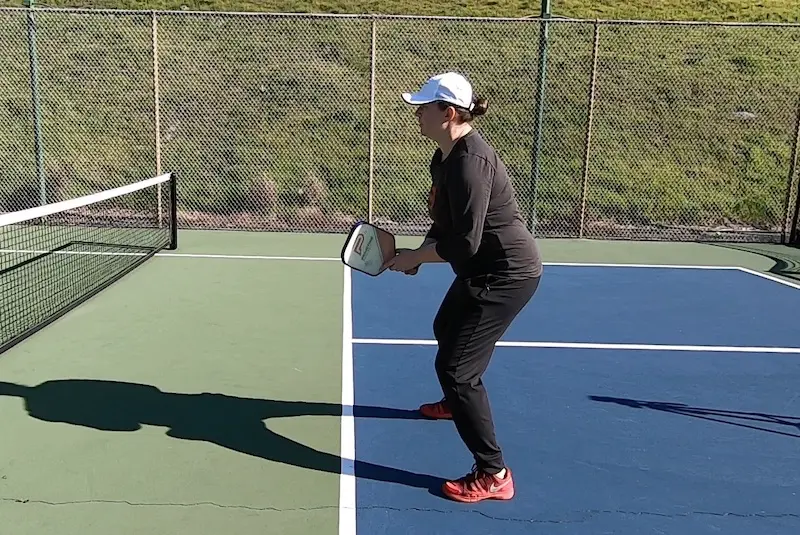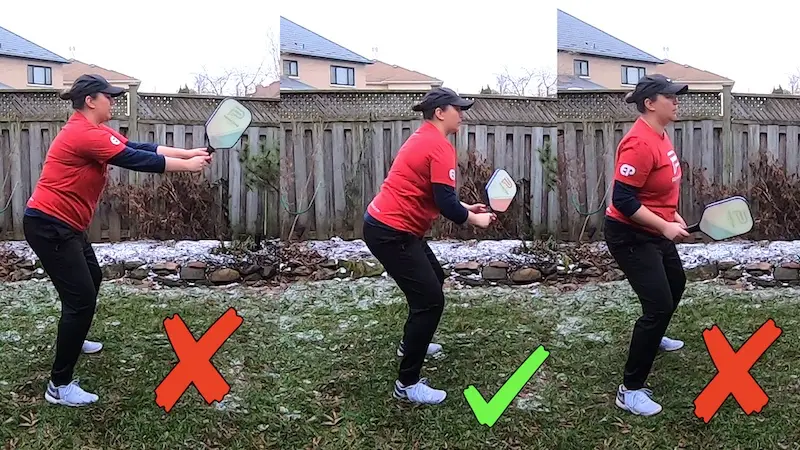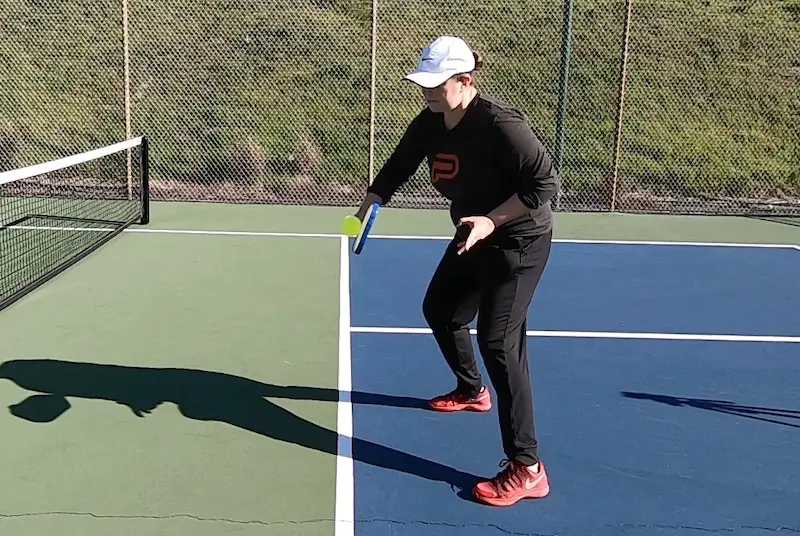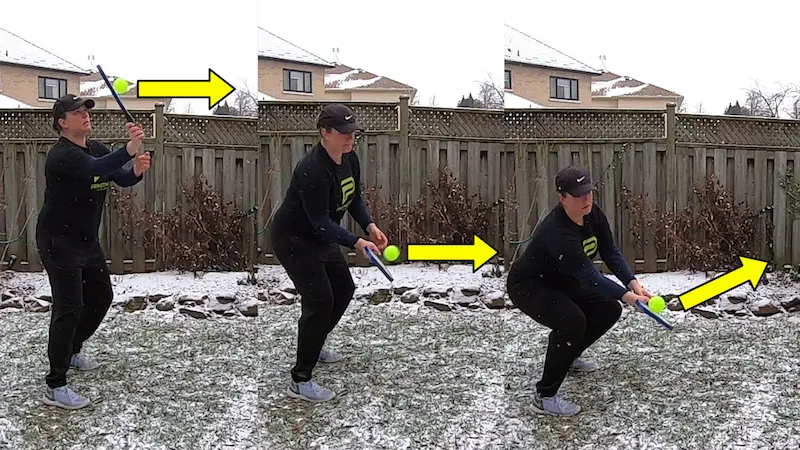Want to gain gain total control over your pickleball volleys? You should! The skill of being able to volley (take the ball out of the air before the boucne) well from any part of the court is a crucial skill to advancing and playing at higher levels of the game. These are the five key tips you need for amazing pickleball volleys:
Tip #1 – Train Your Volleys At Anytime & From Anywhere
You can train and work on your volleys anywhere and at any time. What do i mean by this? Well, one of the beautiful features of volleying is that the ball never actually touches the ground. You’re hitting it out of the air, so you don’t need to be on a surface that provides a predictable bounce, such as a pickleball court.
No Pickleball Court or Partner Needed
You can be on grass, you can be doing it in the pool, it can be snowing, you can do it on gravel you can, do it on brick, just so long as you’re not doing it on an uneven surface where you’ll injure yourself. You need to have stable footing but the ball doesn’t need to bounce true because the ball will never hit the ground. That allows for you to use any reasonably flat surface as long as you won’t lose your footing in any way.
You can do it with a partner or against a wall and what goes hand in hand with being able to work on your volleys from anywhere is that it opens up so much opportunity for you to also hit your volleys at anytime.
For example, when you’re at a crowded set of courts and rotating on and off the court frequently so that all can get an equal chance to play, you can go ahead and get in a little volley training off to the side anytime you find yourself waiting for court time. Grab a pickleball buddy and get after it.
Tip #2 – Athletic Stance & Read Position

When hitting volleys, you’ll want to have a slight knee bend and a slight forward tilt with your upper body. You don’t want to be standing straight up with your knees locked nor do you want to have your torso straight up. You don’t want to be in a deep squat either. That’s not sustainable in the long ran and not necessary.
If the ball does go low and you have to have a low contact and are reaching in to take it as a volley then yes, get low with your knees, but you don’t have to stay there. You can come back out of it right after you’re down with that low shot.
But you do want to have a slight knee bend a slight athletic stance at all times between your volleys so that you can engage your legs somewhat as you’re hitting those volleys.
You toes should be pointed forward throughout your ready position and most of your volleys so you can stay as close as possible up towards that non-volley zone line. If you have to move to one side or the other then you can use a shuffle step. You don’t typically don’t ever want to step forward because obviously that would be a fault because you’re stepping into the kitchen since you are typically up at the kitchen when you’re volleying.
Tip #3 – Have “Goldilocks” Elbows

Goldilocks elbows? What’s that!
What I mean by that is to hold your elbows just a little bit out in front you. You don’t want to have them straight out and arms locked out in front. And you don’t want to have them so relaxed that they’re by your side and basically stuck against your body. You want to have the…juuuuuuust right!
One of the main reasons you don’t want your arms straight out in front of you with elbows locked and holding your paddle up high is that when you’re up at the non volley zone line the ball is never going to be coming that high. And if it is coming that high and hit hard then there’s a very good chance that it’s going out. It it’s slow the you will have time to get your hands and paddle up there to attack it.
You’re not really ready in a high position. It’s kind of like a fake ready position because you “look” really ready but you’re typically going to be contacting shots when you’re up at the non-volley zone at a spot that’s lower down towards the middle of your body. And if it’s a low volley, it’ll be down much lower.
Very rarely, unless it’s an attackable ball will you be making contact up high and conversely you don’t want to have your arms and elbows down resting against the side of your body either because then you’re very prone to having late contacts and that’s not what you want either.
So you’ll want to have your elbows just a little bit more in front of that so that when you reach out to volley it’s almost right there. You just have to lay your wrist back and the volley should be more or less right there.
And if you have to reach a little bit then you can do that as well but you don’t want to be tucked down because then you’ll just go to the side. Have your elbows slightly forward and then just go a little bit more forward to meet the ball and meet your volley and that will lead to a very strong and stable volley.
So, not too straight and not too bent and down…. Just a little bit in front so that’s why i’ve called them Goldilocks elbows.
Tip #4 – Gentle Turn With No Backswing

Another very important technical point on the volley is to have only a gentle turn on both the forehand and the backhand side. You’re not going to do a full shoulder turn, with your chest facing towards the side like you would on ground strokes because you don’t need a big backswing and you don’t need a big follow-through. There’s already a lot of energy coming on the ball so you really just need to reach your paddle out and give it a push back.
If you need to put a little bit more energy on it, use your legs to just send some more force back in to the ball but you’re really mostly redirecting all the energy that’s already on the ball back and it’s for this reason that you don’t need a big take back. You also don’t need a big follow through in the front for the same reason and furthermore there’s really no time for it because up at the net things are happening a lot quicker.
If the other team is also at the net, your setup and your shot have to be quick because you have to be back to your ready position quick and then ready again for the next shot.
The key of putting power back on it is really about the timing of your push and your contact as you meet the ball with your paddle rather than it is taking big swings. You want to focus more on learning how to redirect that energy back with correct timing of putting your kinetic energy into the shot rather than having to create a lot of energy with swings because, like i said, all the energy you need is already there on most shots for which you will use a traditional volley.
Tip# 5 – Appropriate Finishing Height Relative To Contact

This tip doesn’t get talked about very often but it is very important. Many just don’t realize that this is actually going on when you have high level volleys so you can separate yourself from the back by doing this correctly.
You volley finishing height relative to the height of your contact with the ball will vary.
The gist of this tip is as follows:
If you’re contacting high then you’ll want to finish high. If you’re contacting mid-level or medium then you’ll want to finish mid-level medium and if you’re contacting low then you want to finish medium.
Now, let’s unpack this a better further so we know why this is and what we’re trying to achieve.
If you are contacting high and driving the ball through the court such as hard through your opponent or around them and you’re aiming deep then you’ll want to start high and finish high. If you’re angling your shot off, meaning you’re hitting it shorter in the court and to a sharper angle to get it going off the court towards the side, then you may be hitting a bit high to a high medium. You’ll never be going from high to low medium or very low but you may be coming a little bit down. Point being that, in general, you are going to start high and finish on the higher side to be clear.
The key thing to avoid here, which is what mainly I’m getting at with this point, is that you don’t want to be starting high and finishing low. So, no chopping down, in any case.
A medium contact with a medium finish makes a lot of sense intuitively in my view so there’s really not much explanation needed. You’re going to hit directly through the ball on a level plain. You won’t finish high because that shot will go out and you won’t finish low because that will go in the net.
With a low contact, there is really nowhere to go but up. And since one level above up is medium, that’s where you should end up. You can’t go level or down because both of those shots will end up in the net.
Now with these five tips in mind, get out there and work these volley tips and watch your volley game make a huge jump in levels.